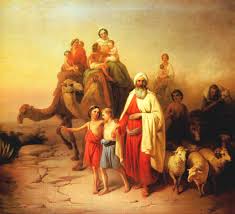பழைய ஏற்பாடு எனப்படும், யூத மதப் புராணக் கதைகள் கொண்ட புத்தகம், எபிரேய மொழ்யில் வரையப்பட்டவை.

கதைப்படி, கல்தேயர் நாட்டைச் சேர்ந்த ஆபிரகாமை, இஸ்ரேலிற்கான எல்லைத் தெய்வம் யாவே அல்லது கர்த்தர், தேர்ந்தெடுத்து, அவன் வாரிசுகளுக்கு கானான் எனப்படும் இஸ்ரேலின் மீதான ஆட்சி உரிமை தந்தார். இதுவே யூத பைபிளின் அடிப்படை.
பண்டைய மத்திய கிழக்கு பட்டணங்களான மரி, நுசி, எப்லா ஆகியவற்றில் நிகழ்த்திய அகழ்வாராய்ச்சிகளில் கிட்டிய கல்வெட்டுகள் -இவை எதுவும் எபிரேயர்களோ, முன்னோர்களுடையதோ இல்லை, என புதைபொருள் அகழ்வாராய்ச்சியினரும், பைபிளியலாளர்களும் இப்போது ஏற்கின்றனர்

கதைப்படி, கல்தேயர் நாட்டைச் சேர்ந்த ஆபிரகாமை, இஸ்ரேலிற்கான எல்லைத் தெய்வம் யாவே அல்லது கர்த்தர், தேர்ந்தெடுத்து, அவன் வாரிசுகளுக்கு கானான் எனப்படும் இஸ்ரேலின் மீதான ஆட்சி உரிமை தந்தார். இதுவே யூத பைபிளின் அடிப்படை.
பண்டைய மத்திய கிழக்கு பட்டணங்களான மரி, நுசி, எப்லா ஆகியவற்றில் நிகழ்த்திய அகழ்வாராய்ச்சிகளில் கிட்டிய கல்வெட்டுகள் -இவை எதுவும் எபிரேயர்களோ, முன்னோர்களுடையதோ இல்லை, என புதைபொருள் அகழ்வாராய்ச்சியினரும், பைபிளியலாளர்களும் இப்போது ஏற்கின்றனர்
மரி கல்வெட்டு; எப்லா கல்வெட்டு; நுசி கல்வெட்டு; கில்கமேஷ் காப்பியம்;சின் - நன்னா நிலாக்கடவுள்.
இவை அனைத்துமே பழைய ஏற்பாடு கட்டுக்கதை என்பதை நிருபிக்கிறது. சுமெரிய,எகிப்து போன்றபடி இஸ்ரேலில் நாகரீகமே கிடையாது.
இவை அனைத்துமே பழைய ஏற்பாடு கட்டுக்கதை என்பதை நிருபிக்கிறது. சுமெரிய,எகிப்து போன்றபடி இஸ்ரேலில் நாகரீகமே கிடையாது.
The supposed Eblaite connections with the Bible is now widely deplored as unsubstantiated,[1][2] The studies on Ebla focus on the civilization of the city.[1] The controversy cooled after much scholarly conflict as well as what some described as interference by the Syrian authorities on political grounds.
முற்பிதாக்கள் - ஆபிரகாம், ஈசாக்கு, யாக்கோபு -கட்டுக்கதை
http://en.wikipedia.org/wiki/Abraham
By the beginning of the 21st century, archaeologists had "given up hope of recovering any context that would make Abraham, Isaac or Jacob credible 'historical figures'".
மரி கல்வெட்டு, எப்லா கல்வெட்டு, நுசி கல்வெட்டு- இவை அனைத்தும் மேம்பட்ட நாகரீகக் குழுவினர், எபிரேயர் அல்லர், எபிரேயர் என்னும் குழு உருவானதே பொ.மு. 8ம் நூற்றாண்டிற்குப் பின் தான்



http://en.wikipedia.org/wiki/Chaldea Chaldeans -கல்தேயர் -இப்பெயர்களே பொ.மு. 1000- 600 இடையிலே தான். இன்னுமொரு கதை ஆபிரகாம் கதையில் -
முற்பிதாக்கள் - ஆபிரகாம், ஈசாக்கு, யாக்கோபு -கட்டுக்கதை
http://en.wikipedia.org/wiki/Abraham
By the beginning of the 21st century, archaeologists had "given up hope of recovering any context that would make Abraham, Isaac or Jacob credible 'historical figures'".
மரி கல்வெட்டு, எப்லா கல்வெட்டு, நுசி கல்வெட்டு- இவை அனைத்தும் மேம்பட்ட நாகரீகக் குழுவினர், எபிரேயர் அல்லர், எபிரேயர் என்னும் குழு உருவானதே பொ.மு. 8ம் நூற்றாண்டிற்குப் பின் தான்
ஆதியாகமம்24: 29-30 அவளுக்கு ஒரு சகோதரன் இருந்தான். அவன் பெயர் லாபான். அவள் சொன்னதையெல்லாம் அவன் கேட்டான். அவன் அவளது காதணிகளையும் கடகங்களையும் பார்த்துவிட்டு கிணற்றருகே ஓடினான். அங்கு கிணற்றருகில் ஒட்டகங்களையும், வேலையாளையும் கண்டான். 31 அவனிடம், “ஐயா, கர்த்தரால் ஆசீர்வதிக்கப்பட்டவரே உங்களை எங்கள் வீட்டிற்கு வரவேற்கிறோம். இங்கே வெளியே நீங்கள் நின்றுகொண்டிருக்க வேண்டாம். நீங்கள் இளைப்பாற ஒரு அறையை ஏற்பாடு செய்துள்ளேன். உங்கள் ஒட்டகங்கள் தங்கவும் ஏற்பாடு செய்துள்ளேன்” என்றான். 32 ஆபிரகாமின் வேலைக்காரன் அந்த வீட்டிற்குப் போனான். லாபான் அவனுக்கு உதவினான். ஒட்டகங்களுக்கு உணவு கொடுத்தான். |
http://www.marumoli.com/2014/02/%E0%AE%B5%E0%AF%87%E0%AE%A4%E0%AE%BE%E0%AE%95%E0%AE%AE%E0%AE%A4%E0%AF%8D%E0%AE%A4%E0%AE%BF%E0%AE%B2%E0%AF%8D-%E0%AE%A4%E0%AE%B5%E0%AE%B1%E0%AF%81/
Camel : Recent excavations in the Timna Valley by Lidar Sapir-Hen and Erez Ben-Yosef discovered what may be the earliest domestic camel bones found in Israel or even outside the Arabian peninsula, dating to around 930 BCE.
வேதாகமத்தில் வரலாற்று முரண்பாடுகள் | அகழ்வாய்வு நிபுணர்கள்!
Camel : Recent excavations in the Timna Valley by Lidar Sapir-Hen and Erez Ben-Yosef discovered what may be the earliest domestic camel bones found in Israel or even outside the Arabian peninsula, dating to around 930 BCE.
The archaeologist William F. Albright writing even earlier saw camels in the Bible as an anachronism.
இஸ்ரேலில் ஒட்டகம் புழங்கத் தொடங்கியது பொ.மு.930 வாக்கில், புதைபொருள் அகழ்வாராய்ச்சியில் கிடைத்த எலும்புகள் கூறும் உண்மைகள். இஸ்ரேல் டெல்-அவிவ் பல்கலைக் கழக ஆய்வுகள்.
இது சுரங்கம், அரசு பணி போன்றவற்றின் பயன்பாடு- ஆபிரகாமிற்கு 1000 வருடம் பின்பு தான் என நிருபிக்கிறது.
ஆனால் இங்கு உள்ளது, ஆபிரகாம் வீட்டு கொட்டிலில் ஒட்டகம், அது எப்போது நடந்தது. இது ஆபிரகாமிற்கு 1800 வருடம் பின்பு தான்
பரவலாக வீட்டுக் கொட்டிலில் கட்டிபயன்படுத்தியது பொ.மு.200 வாக்கில்தான்.
விக்கிபீடியா சொல்வது ஏசுவிற்கு 100 -200 ஆண்டுகள் முன்பு தான் பரவலாக ஒட்டகம் பயன்படுத்தியதைக் காண்கிறோம்- இங்கே
http://en.wikipedia.org/wiki/Exodus_from_Egypt
// The mention of the dromedary in Exodus 9:3 also suggests a later date of composition – the widespread domestication of the camel as a herd animal did not take place before the late 2nd millennium, after the Israelites had already emerged in Canaan, and they did not become widespread in Egypt until c.200–100 BCE.//
// The mention of the dromedary in Exodus 9:3 also suggests a later date of composition – the widespread domestication of the camel as a herd animal did not take place before the late 2nd millennium, after the Israelites had already emerged in Canaan, and they did not become widespread in Egypt until c.200–100 BCE.//



No comments:
Post a Comment